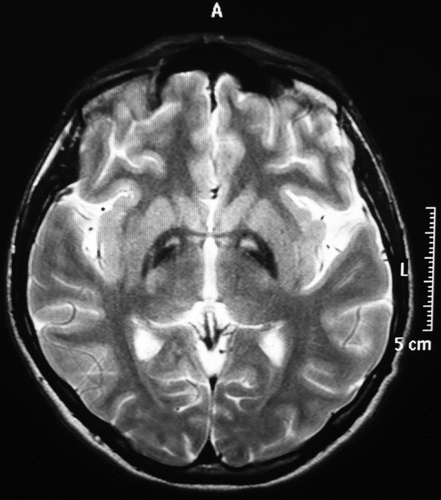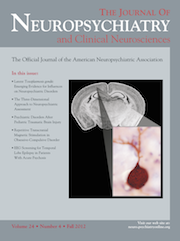Panthothenate Kinase-Associated Neurodegeneration (PKAN) Presenting With Language Deterioration, Personality Alteration, and Severe Parkinsonism
To the Editor: Caused by mutations in the PANK2 gene located on chromosome 20p13-p12.3, panthothenate kinase-associated neurodegeneration (PKAN) is an inherited neurodegenerative disorder. Clinical symptoms for the classical type include parkinsonism, progressive rigidity, mental deterioration, and visual disturbances, usually beginning in adolescence.1 The atypical type is reported to have later onset and to be associated with various psychiatric manifestations, such as impulsivity, anger outbursts, personality alterations, and emotional lability.2
We hereby report a case that was initially diagnosed with selective mutism and psychotic depression, who subsequently developed severe rigidity and dysphagia after the administration of antipsychotics. His magnetic resonance imaging (MRI) scan revealed characteristic findings of PKAN.
Case Report
“Mr.B.” is an 18-year-old, single young man, born to a healthy 25-year-old mother and a 32-year-old father who were distant relatives. The patient was admitted to our outpatient adolescent mental health unit with the complaints of personality changes, lack of personal hygiene, and not speaking. All of his problems have emerged gradually in the last 2 years. First, failure in academic performance was noticed. Irritability, appetite loss, and poor personal hygiene were subsequently added. His speech has declined progressively. His motor milestones and language development were within normal limits.
He was diagnosed with selective mutism and depressive disorder and was prescribed fluoxetine 20 mg per day, along with psychotherapy scheduled weekly.
His speech lacked spontaneity, with extreme poverty of content. His affect was inappropriate. With the provisional diagnosis of psychotic depression, fluoxetine dose was increased to 40 mg per day, and olanzapine 2.5 mg per day was added. The olanzapine dose was increased to 10 mg per day gradually over 1 month. After 1 month, since there was no improvement, he was admitted to the inpatient ward. Medications were shifted to venlafaxine 75 mg per day and aripiprazole 15 mg per day. After 4 months, dystonia in both legs developed, and biperiden was added to the regimen and gradually increased to 4 mg/day. Unexpectedly, in spite of biperiden treatment for 2 weeks and discontinuation of aripiprazole, extrapyramidal symptoms persisted; bilateral bradykinesia, rigidity, and cervical dystonia developed both in upper and lower extremities, as well as dysphagia. Occurrence of dysphagia and the severe rigidity after the administration of antipsychotics required considering a disorder involving basal ganglia. First, we considered Wilson’s disease, but ophthalmologic consultation did not reveal any pathological findings, and his blood and cerebrospinal fluid copper levels were within normal limits. His cranial MRI showed “eye of the tiger” sign, known to be a characteristic finding of PKAN. This sign consists of a central region of hyperintensity, surrounded by a ring of hypointensity in the anteromedial globus pallidus (Figure 1).3 After 9 months of tetrabenazine 37.5 mg/day, quarterly botulinum toxin injections to the cervical region, clonazepam 4 mg/day, and biperiden 6 mg/day treatment, his rigidity and dysphagia were considerably improved. However, he remained largely mute.

1 : A novel pantothenate kinase gene (PANK2) is defective in Hallervorden-Spatz syndrome. Nat Genet 2001; 28:345–349Crossref, Medline, Google Scholar
2 : How broad is the phenotype of Hallervorden-Spatz disease? Acta Neurol Scand 2001; 103:201–203Crossref, Medline, Google Scholar
3 : The eye-of-the-tiger sign. Radiology 2000; 217:895–896Crossref, Medline, Google Scholar



